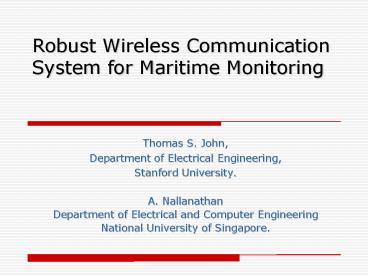Robust Wireless Communication System for Maritime Monitoring - PowerPoint PPT Presentation
Title:
Robust Wireless Communication System for Maritime Monitoring
Description:
... problem, we terminate the phase trellis of differentially encoded data at predetermined indices. ... OFDM, the serial concatenation of sub-trellises yield: ... – PowerPoint PPT presentation
Number of Views:48
Avg rating:3.0/5.0
Title: Robust Wireless Communication System for Maritime Monitoring
1
Robust Wireless Communication System for
Maritime Monitoring
- Thomas S. John,
- Department of Electrical Engineering,
- Stanford University.
- A. Nallanathan
- Department of Electrical and Computer Engineering
- National University of Singapore.
2
Introduction
- Communications in maritime protection via the
ability of rapidly field flexible, wireless,
ad-hoc mobile networks. - Inaugural partner project COASTS (Coalition
Operational Area Surveillance and Targeting
System). - COASTS mission is to develop low cost,
unclassified unattended sensor networks. - Provide real-time information for tactical and
remote command-and-control. - Wireless Technology Combination of 802.11 and
802.16.
3
Wi-Fi 802.11n and WiMax 802.16
- 802.11n Wi-Fi standard is to emerge in Mid-2006.
- Date rate for 802.11n 100 Mbits/s.
- WiMax 802.16 is going to be the real future of
wireless (peer to peer communication, range upto
50km). - MIMO-OFDM is recommended for Wi-Fi and WiMax.
- Maritime Protection Combination of 802.11 and
802.16. - Hence, MIMO-OFDM transceiver design becomes
important.
4
MIMO-OFDM
- OFDM is a potential scheme for high data rate
wireless transmission. - OFDM can be combined with multiple transmit and
receive antennas MIMO-OFDM
5
MIMO-OFDM Receiver
- Several detection schemes have been proposed for
MIMO systems. Ex ZF nulling and IC with
ordering, MMSE nulling and IC with ordering, etc - However, performance is inferior to ML detection.
- ML detection Complexity grows exponentially with
number of Transmit antennas. - To reduce the complexity, Sphere decoding.
- All are hard-decision algorithms. Suffer
performance loss when concatenated with channel
decoder. - List sphere decoding with soft output.
- But complexity is higher than hard-decision
decoding. - We use SMC methodology to obtain near-optimal
performance with low complexity.
6
System Model Transmitter
7
Receiver structure
8
Problems in Conventional SMC
- Conventional Sequential Monte Carlo (SMC)
detectors Based on Sequential importance
sampling and resampling. - Resampling is important in SMC to counter the
inherent problem of degeneracy (as SIS algorithm
progresses, it tends to carry more imputed
trajectories of low importance weights that do
not contribute significantly to the final
estimation) . - Problems with resampling
- (a) impoverished trajectory diversity
- (b) loss of independence among imputed
trajectories. - To solve this problem, we terminate the phase
trellis of differentially encoded data at
predetermined indices.
9
System Model Transmitter (Contd)
- Termination period is K, i.e., at every
transition bits are inserted to
terminate at the desired state. - This terminated state acts as the initial state
for next symbols. - Consider (K-1) M-PSK symbols that are
differentially encoded to yield the
sub-trellis - complete sub-trellis
10
System Model Transmitter (Contd)
- For MIMO-OFDM, the serial concatenation of
sub-trellises yield - Sequence is demultiplexed to yield
, - sent through the conventional OFDM
transmitter.
11
Transmission Grid Example
- When does not divide , we see that
there is at least one termination state at any
frequency. - These terminated states serve as pilot symbols to
estimate the channel parameter - The phase of these pilots could be made to cycle
through each of the M states in sequence.
12
Receiver Structure
- Turbo structure SISO NR-SMC detector (inner) and
SISO channel decoder (outer). - SISO NR-SMC inputs channel estimates,
the symbol prior probabilities
and the samples - SISO NR-SMC output a posteriori symbol
probabilities - SISO Channel decoder delivers an update LLR of
code bits from priori LLR. - SISO NR-SMC detector and channel decoder exchange
extrinsic information.
13
Simulation Results
- Parameters
- , K3.
- QPSK modulation (M4)
- Channel bandwidth of 800 kHz is divided into N64
subchannels. - Symbol duration Guard interval
- Uniform (UNI), typical urban (TU), and hilly
terrain (HT) delay profiles. - Doppler frequency of 40 Hz.
- L3, delay spreads are ,
and - MMSE channel estimation.
- Number of Turbo iterations 4
14
Simulation Results (Contd)
- BER of Convolutionalcoded MIMOOFDM (SISO
Channel decoder MAP Algorithm)
15
Simulation Results (Contd)
- BER of LDPCcoded MIMOOFDM (SISO Channel
decoder Message passing algorithm)
16
Simulation Results (Contd)
17
Simulation Results (Contd)
18
Simulation Results (Contd)
19
Simulation Results (Contd)
20
Simulation Results (Contd)
21
Conclusions
- Periodic termination of differential phase
trellis enhance the trajectory diversity and
retard weight degeneracy. - This allows us to circumvent the resampling step.
- SMC for Convolutional coded and LDPC coded
MIMO-OFDM system employing periodically
terminated DQPSK gives the performance close to
perfectly known channel bound within 1 dB and
0.75 dB respectively. - For a given number of transmit and receive
antennas, an even distribution of antenna
elements between the transmitter and receiver
achieves the best BER performance.































